Article: Elucidating the D.montana complex
Jun 18, 2014 8:20:34 GMT
Aidan, marcel, and 1 more like this
Post by Fernando Rivadavia on Jun 18, 2014 8:20:34 GMT
Hello everyone,
Here is another call to correct your plant labels!
A few colleagues and I have just published a 35-page review of the D. montana complex. Like our previous publications on Brazilian sundews, this paper has been decades in the making and it has definitely been the most “complex” of all the sundew complexes in Brazil, at least in historical terms.
Since D. montana and D. tomentosa were originally published by Saint-Hilaire nearly 200 years ago, there have been endless cycles of synonimizations and of lumping with unrelated species – culminating with the absurd Flora Neotropica in 2005, where ten names were lazily lumped under D. montana.
In our new circumscription of the D. montana complex, we have left only D. montana, D. tomentosa var. tomentosa, D. tomentosa var. glabrata, D. tentaculata, and a new (& narrow endemic) species D. spirocalyx. This is supported by characters such as leaf shape & vernation, chromosome numbers, and molecular phylogenetic data.
Excluded from the D. montana complex (hopefully permanently) are the following taxa: D. hirtella var. hirtella, D. hirtella var. lutescens, D. schwackei Rivadavia, D. parvifolia Saint-Hilaire (= D. communis), D. cayennensis Sagot ex Diels (including D. pumilla Santos, D. colombiana Fernández, D. panamensis, and D. sanariapoana Steyermark as synonyms), D. montana f. parviflora Chodat (= D. communis), and of course D. roraimae (Klotzsch ex Diels) Maguire & Laudon.
Hopefully our new publication will set the record straight for a long while with the D. montana complex!
Anyway, see below some pics and extra info for each taxon.
First we have D. montana, which is the most widespread in the complex. Through herbarium specimens, we’ve newly discovered that this species is very common on the eastern slopes of the Andes in Bolivia, and possibly also extends into Peru and Argentina. Maybe as a result of this huge geography, it is probably not surprising that it is also somewhat diverse morphologically. However we were not able to establish clear-cut morphological lines, and thus opted to describe 3 morphotypes: Typical, Southern, and Central-western morphotypes.
The characters that distinguish D. montana include the fact that it tends to go completely dormant in the dry season, it flowers in the summer, does not form stems with age, has uniformly-sized glandular trichomes from base to apex of the scapes, long and broad ovate to oblong-ovate sepals, and has relatively delicate leaves that are oblong, oblong-spatulate or more rarely spatulate.
Here are two pics of D. montana rosettes where you can see the narrow leaves:
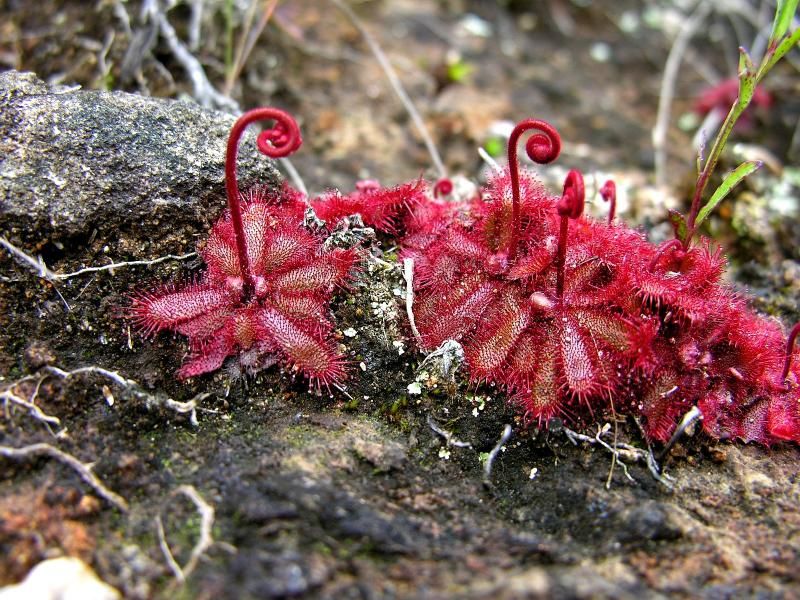

And two pics showing the highly glandular scapes of D. montana (pics by Nilber Silva):
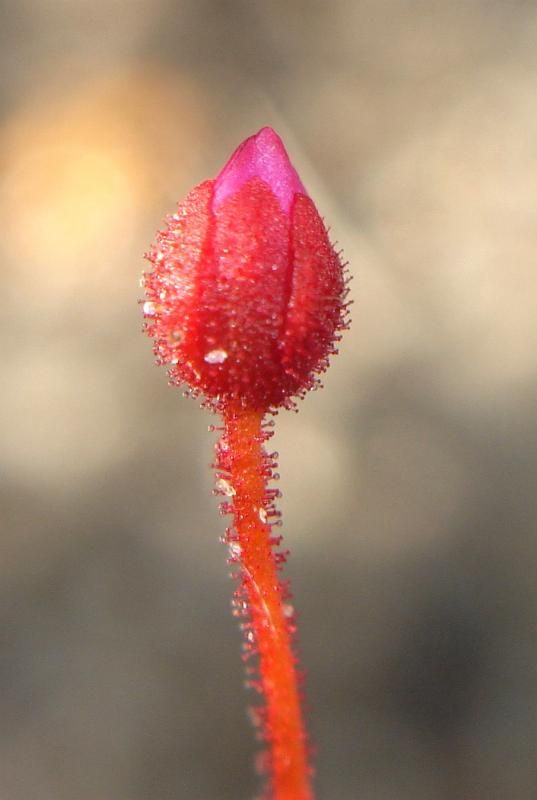
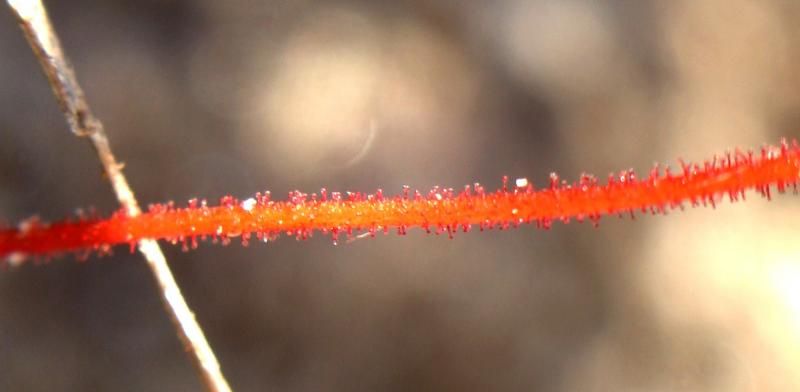
Then we have another widespread and very abundant species: D. tomentosa, distinguished from other taxa by its obovate to oblong-obovate leaves (rarely oblong), with wide petioles (0.4–3 mm in width). It also shows some morphological variation across the range. Variations in density of the eglandular hairs on scapes seems to support the original description by Saint-Hilaire, splitting D. tomentosa into two varieties: D. tomentosa var. tomentosa with hairy scapes and D. tomentosa var. glabrata with glabrous to subglabrous scapes. We decided to keep these two infraspecific taxa at the varietal rank, due to the huge overlap in their geographical ranges, possible hybridization, and the fact that the sole distinguishing character (scape eglandular indumentum) is not easily quantifiable.
Here's a typical dense colony of D. tomentosa at a seepage:
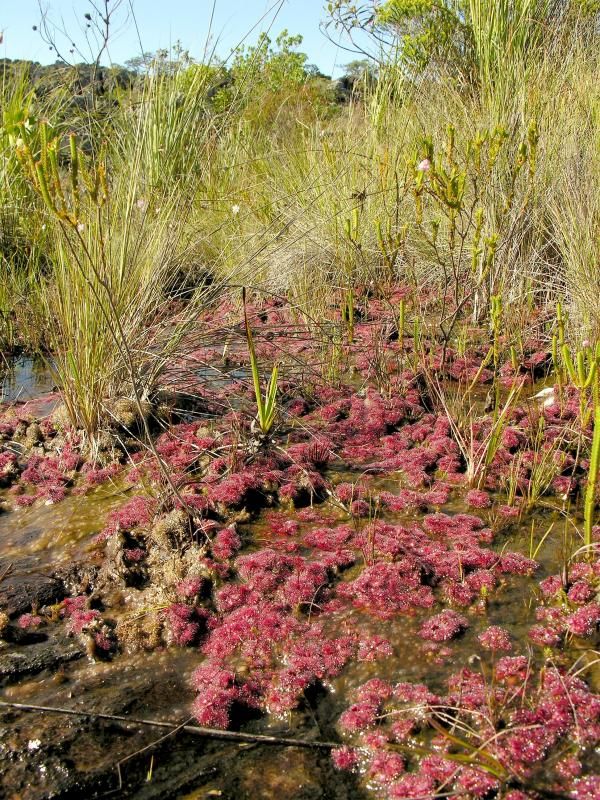
Here's a view of a D. tomentosa rosette with typical broad leaves. Notice the scapes are practically hairless, meaning this is D. tomentosa var. glabrata:
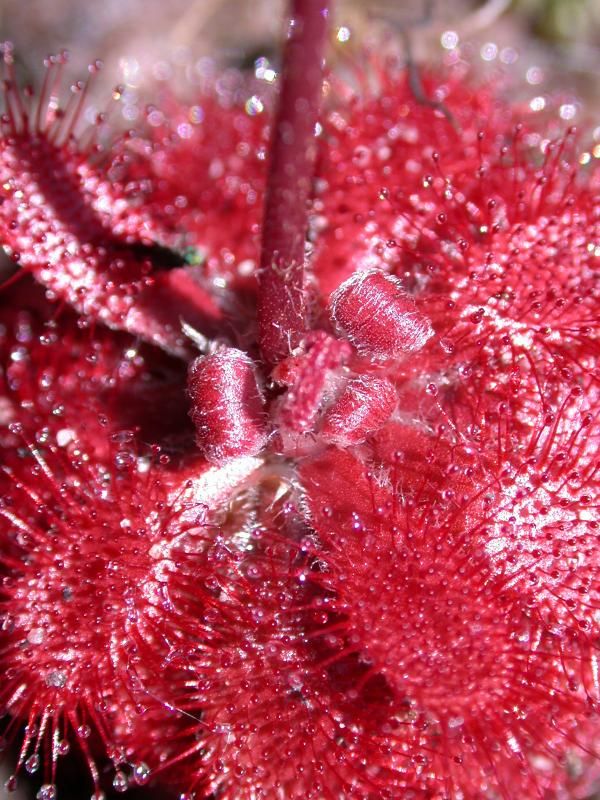
Here are two pics of D. tomentosa var. glabrata, with its mostly hairless scapes (glandular only):
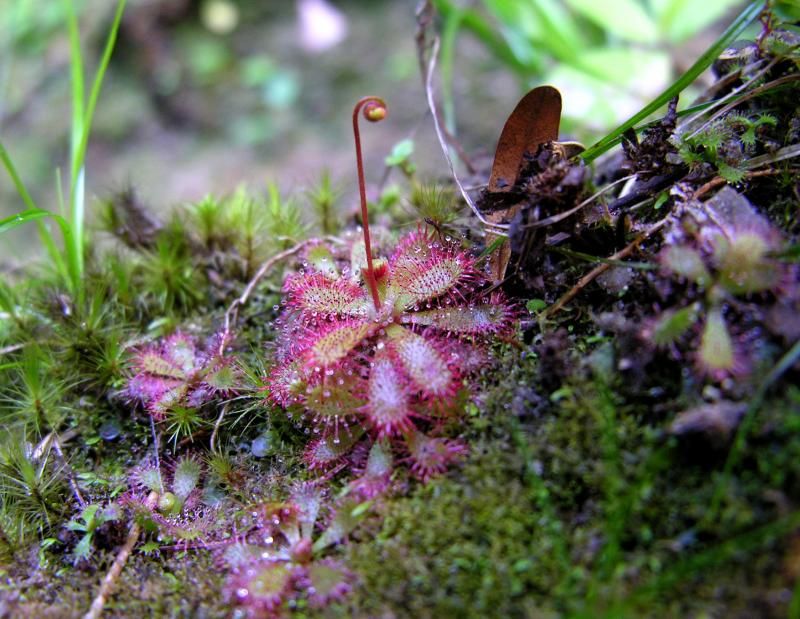

Here are a few pics of D. tomentosa var. tomentosa with its ultra-hairy scapes:
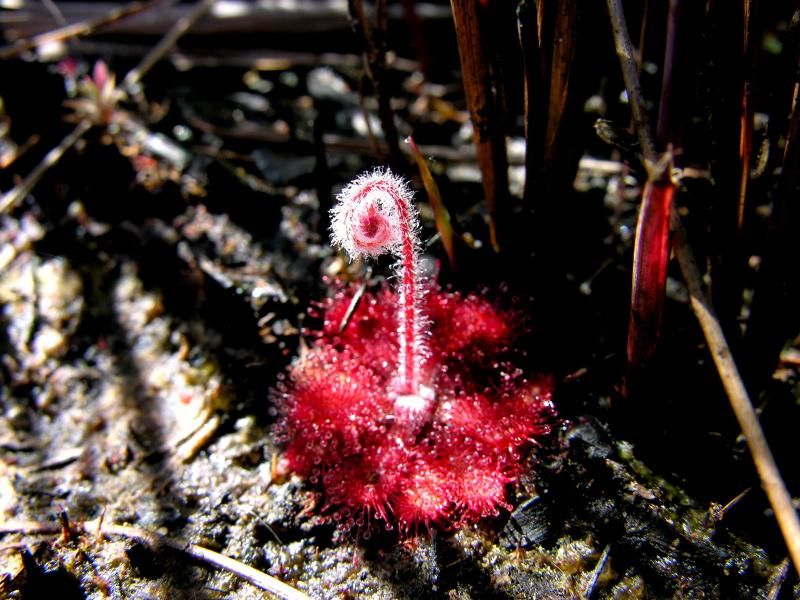

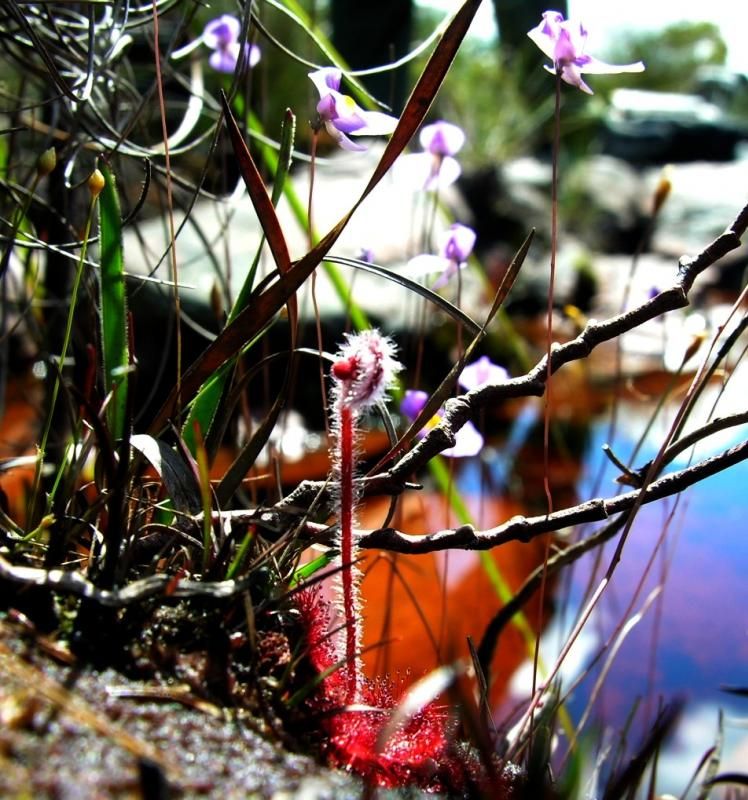
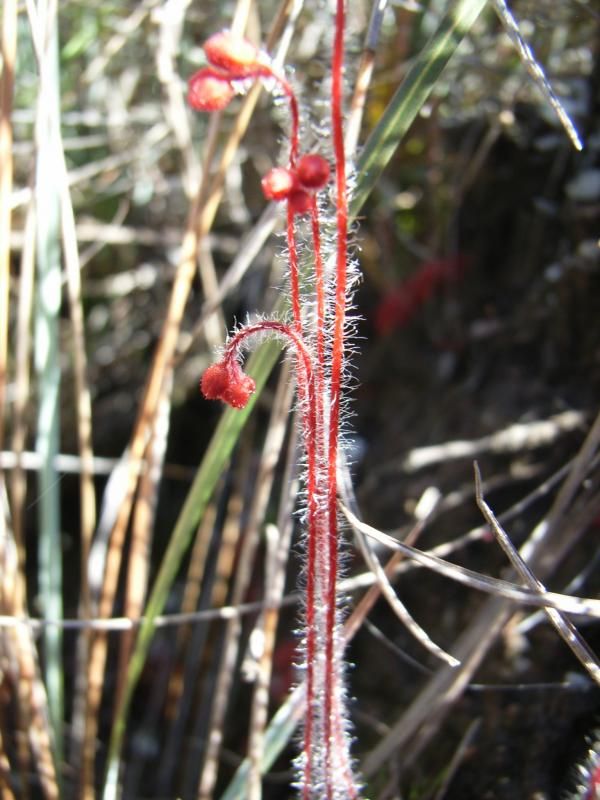
So why did we keep two taxa as variaties of D.tomentosa instead of at higher rank (or none)? Even though the extremes are often found growing in the same habitats with no intermediates. However hybrids are known and there are numerous populations somewhat intermediate in regards to scape hairyness. Thus, we followed Saint-Hilaire and kept varietal rank due to the difficulty in quantifying this character, until further evidence is presented. Here's a plant we classified as var.tomentosa, since hairs were found all the way up the scape, even if less dense than the ones above (pics by Nilber Silva):
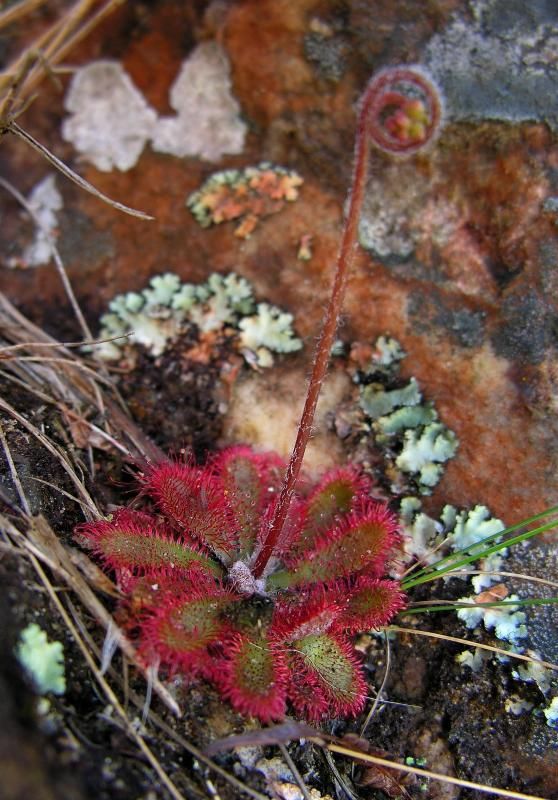
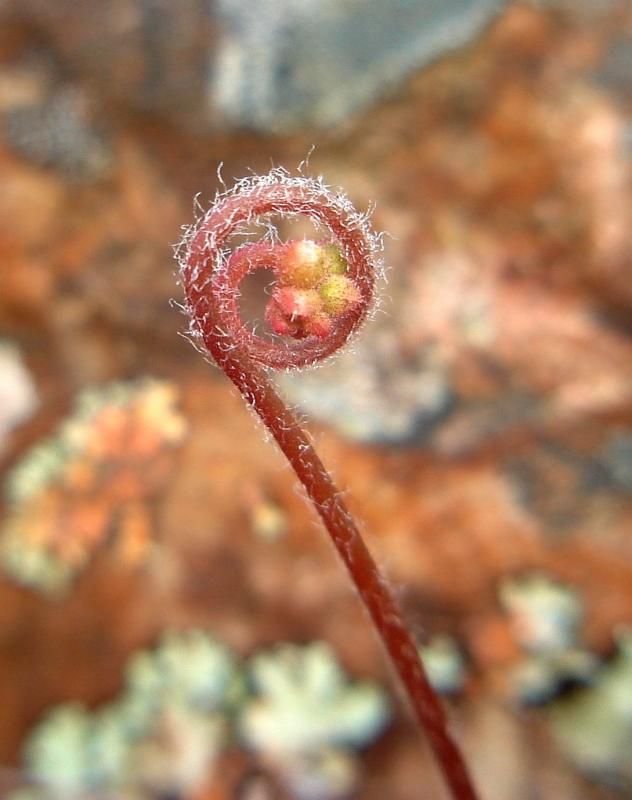
And just as a reminder, D. tomentosa (both varieties) are known to freely form hybrids with D. grantsaui almost everywhere they meet, the hybrid being known as D.X fontinalis.Here's a pic of D. tomentosa var. tomentosa (L) and D.X fontinalis (R):
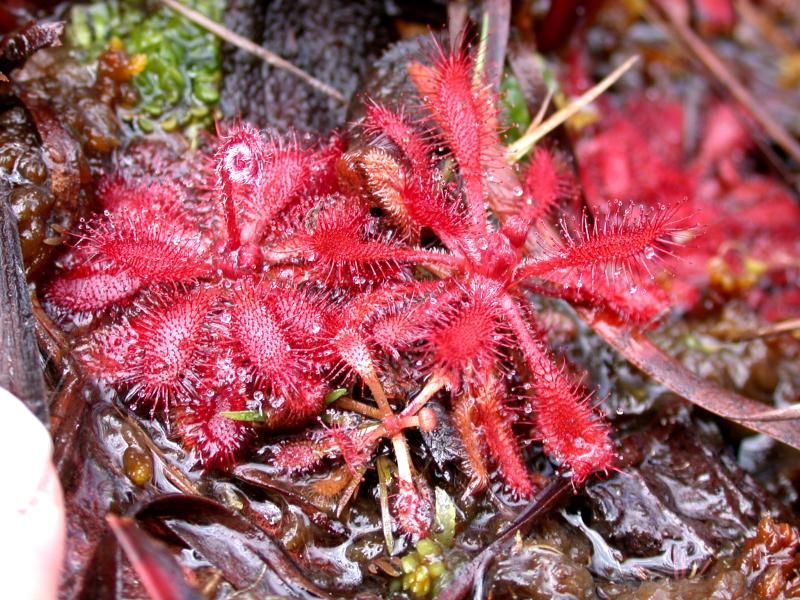
A relatively recent addition to this group is D. tentaculata, which I published in 2003. This species can be distinguished by its obovate, obovate-cuneate or cuneate leaves with conspicuous apical retentive (“snap) tentacles, tendency to form short stems of accumulated dead leaves, and a newly-discovered character unique among other Brazilian species: the way the young leaves unfurl (vernation) is geniculate (versus circinate in other tetraploid Brazilian taxa and the more common geniculate-involute vernation of most other New World species).
Here are some pics of D. tentaculata:
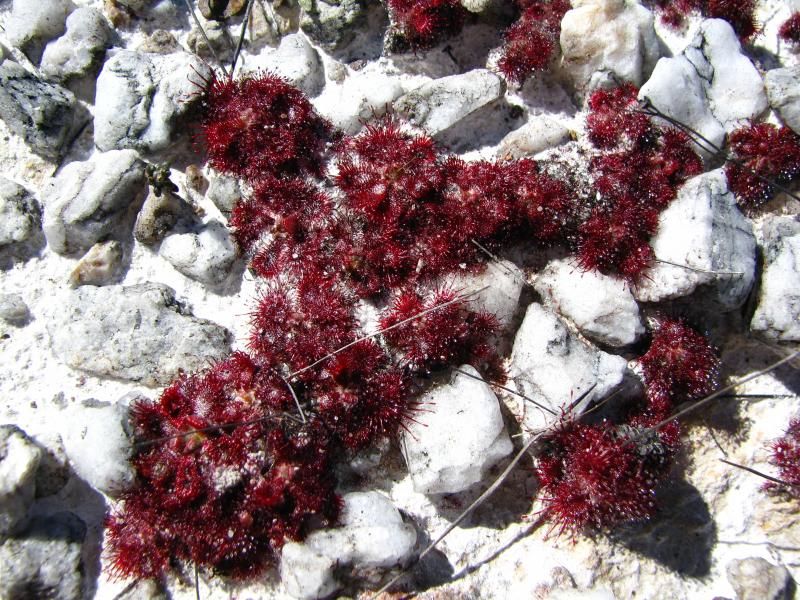
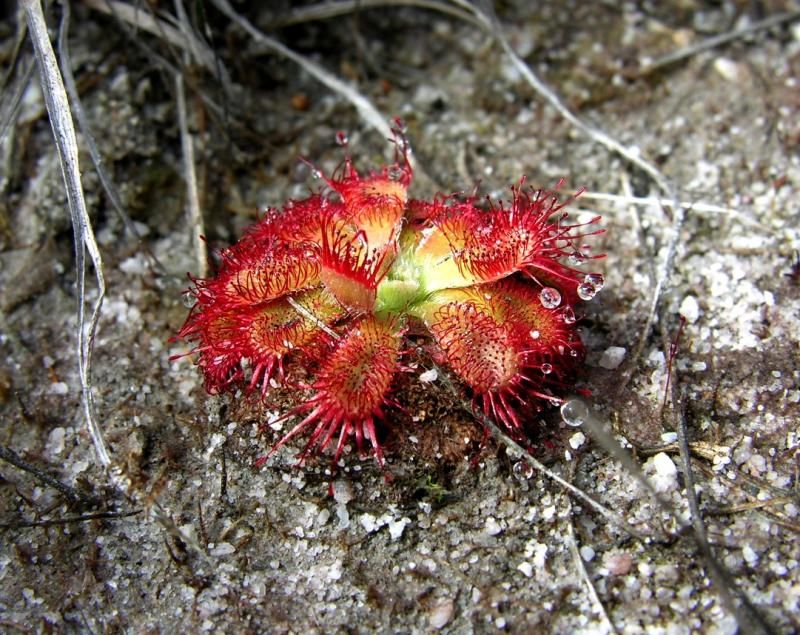
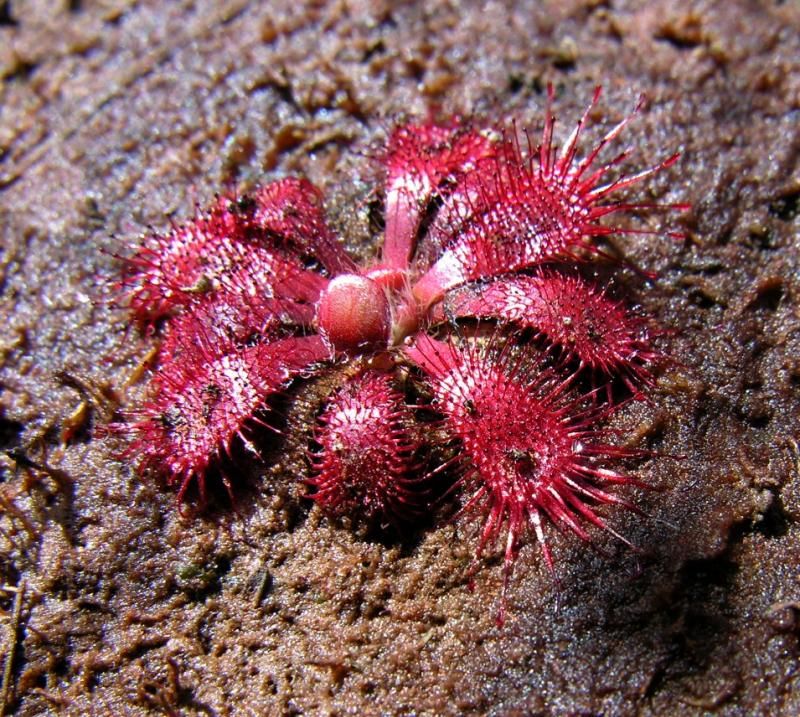
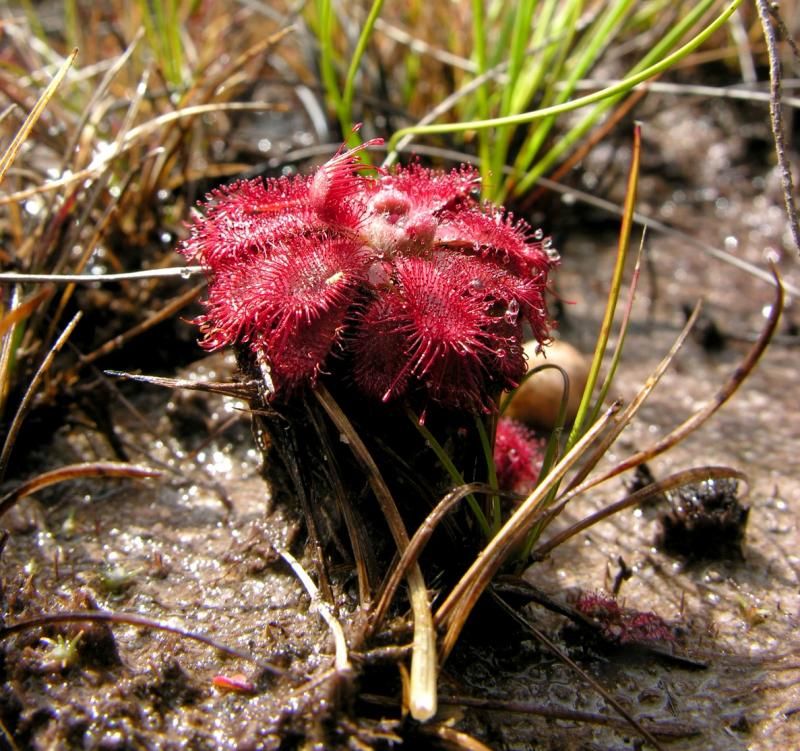
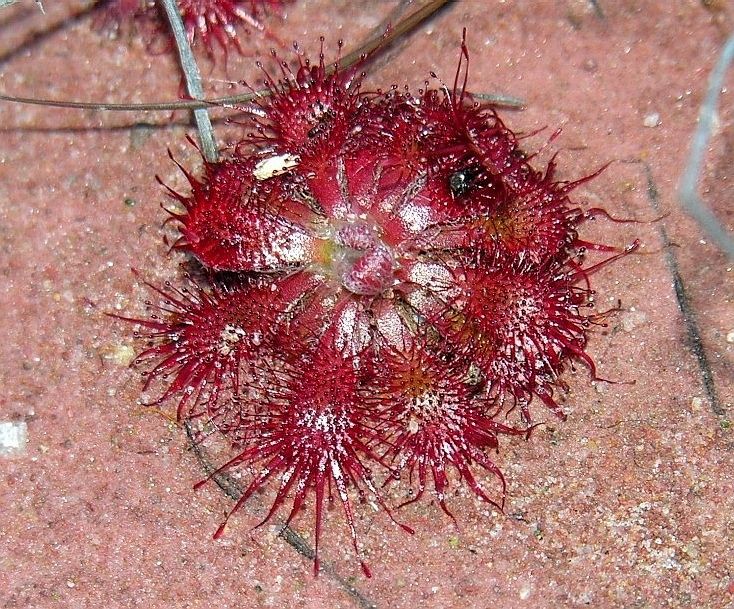

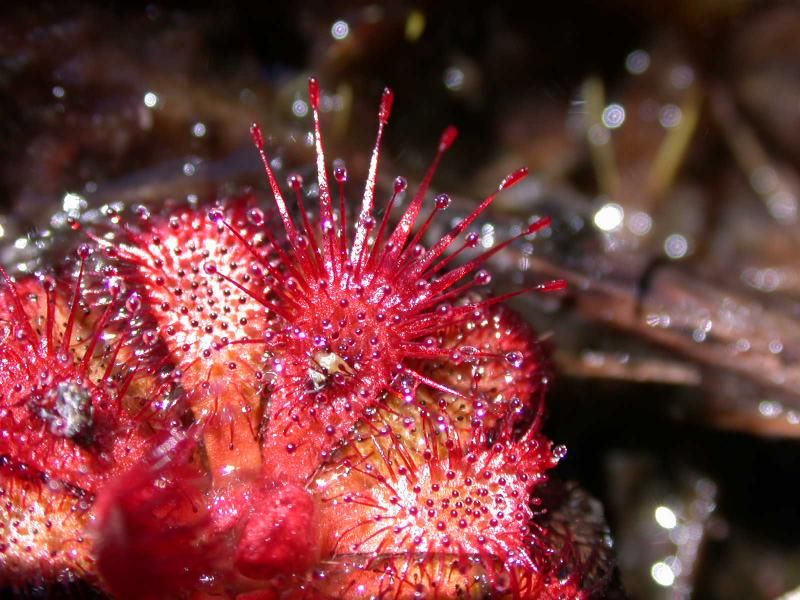
And finally we have the new species D. spirocalyx, a narrow endemic from the Serra do Cipó in SE Brazil. I originally “discovered” this species as a herbarium specimen back in the early 90’s, but only saw it in the field in 1999, thanks to precise location data provided by my friend Ms.Chiaki Shibata from Japan, who had visited the Serra do Cipó and showed me lovely pics of local CPs, including one where I recognized the plant I only knew from herbarium specimens until then (and thus the reason why it was called for many years D.sp. ”Shibata”).
Subsequent and extensive explorations over the past 15 years have only turned up a few, mostly small populations, usually growing in sandy quartzitic soils or borderline habitats where sandy soils meet mounds of white quartz gravel mixed with fine sand.
Drosera spirocalyx is distinguished by characters such as its bicolored leaves with green petioles and wine red lamina, villous adaxial petiole surface and whole abaxial leaf surface, short scapes with few flowers that open at the height of the dry season, and by the sub-orbicular to broadly ovate sepals with rounded (rarely subobtuse) apex. And it’s the sepals that give this plant its name, due to the fact that the margins of the sepals uniquely (among New World sundews) overlap when in bud and form a pyramidal projection at the fusion point between adjacent sepals.
Here’s D. spirocalyx, forming typical (clonal?) clumps:
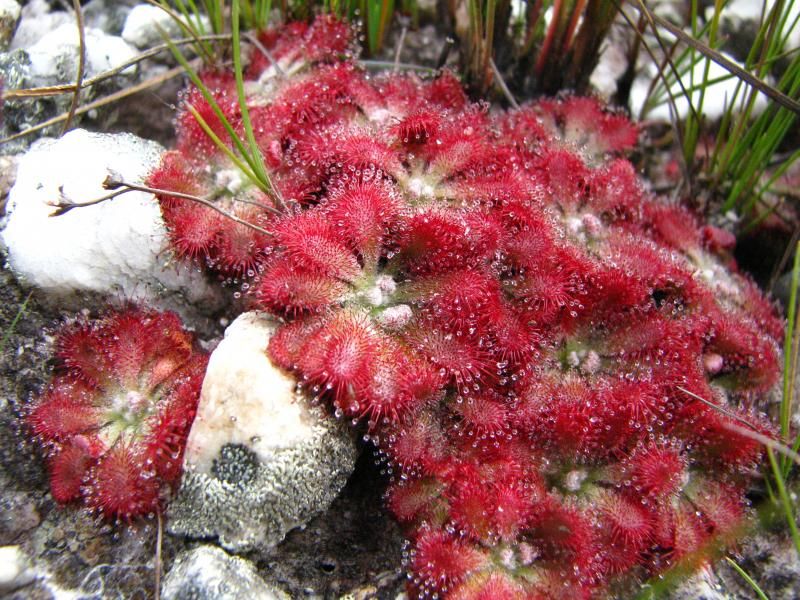
And here you can see the plants forming columns of dead leaves (also present in D. tentaculata and D. tomentosa):


This pic by Paulo Gonella shows the characteristic that gives D. spirocalyx its name. Notice how the sepals are large and overlapping – so much so that they even form a pyramidal projection where adjacent sepals fuse. Only one other Drosera species has these bumps: D. stenopetala from New Zealand.
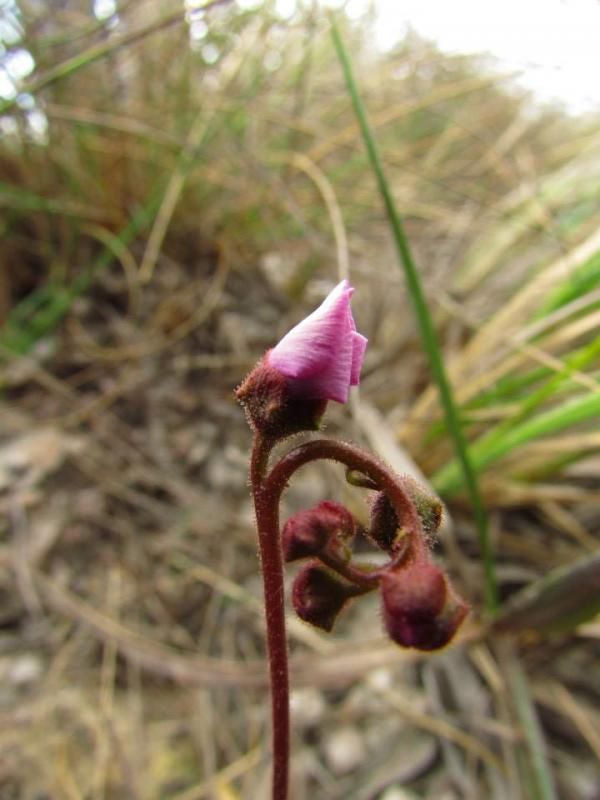
And just for clarity’s sake, here are some of the taxa we’ve excluded from the D. montana complex, starting with D. chimaera, which is possibly the missing link between the montana and villosa complexes:
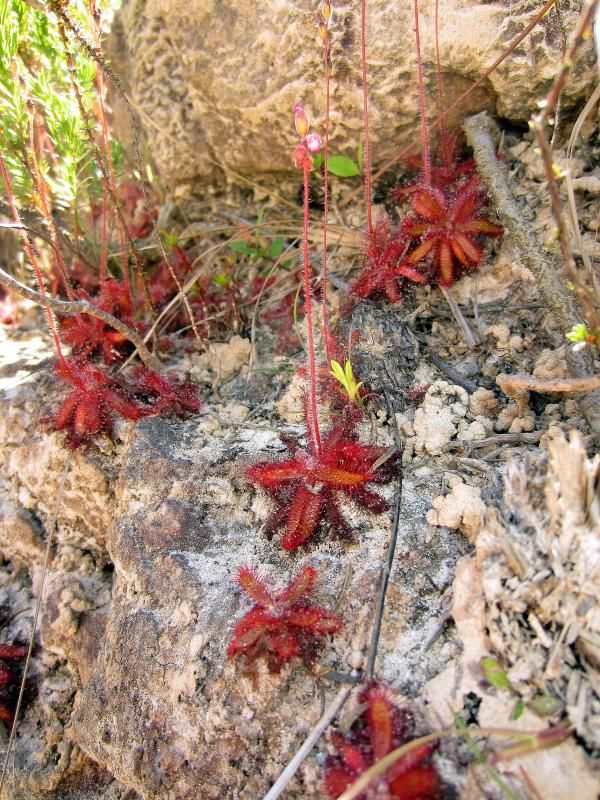
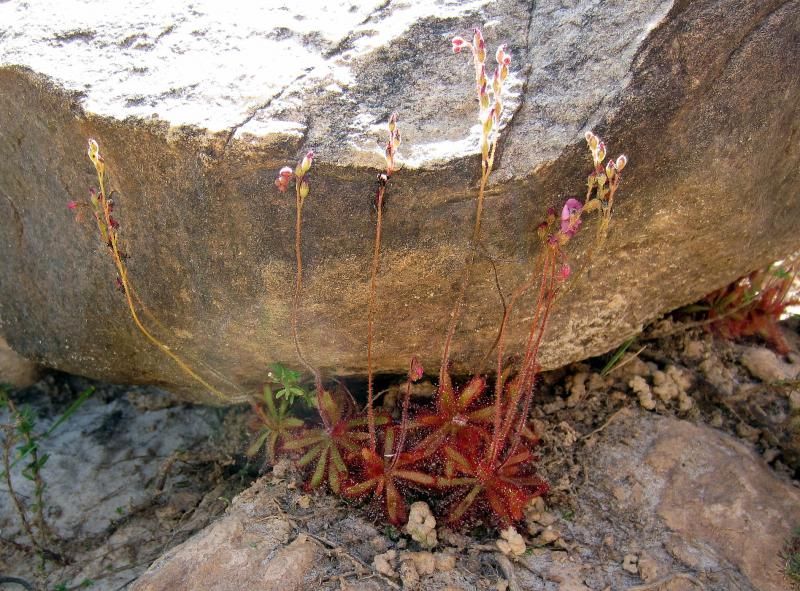
And here’s the beautiful D. schwackei (ex- D.montana var.schwackei) in its amazing white quartz habitat:
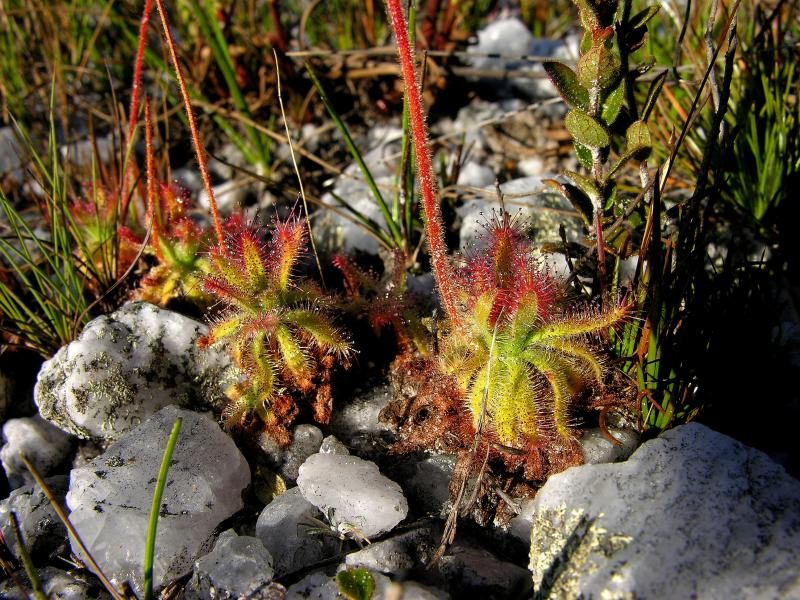
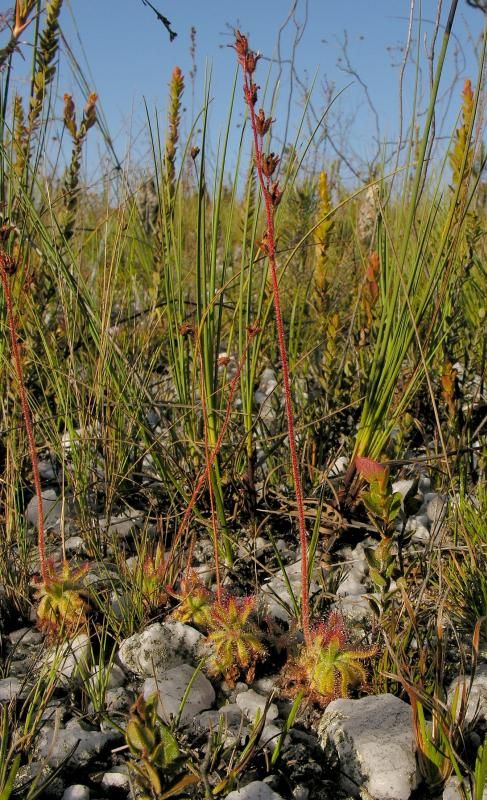
Another species excluded from the complex is D. hirtella (ex-D. montana var. hirtella). Here’s a pic of D. hirtella var. hirtella with its reddish leaves and deeply ascending scapes covered in crisp red hairs:
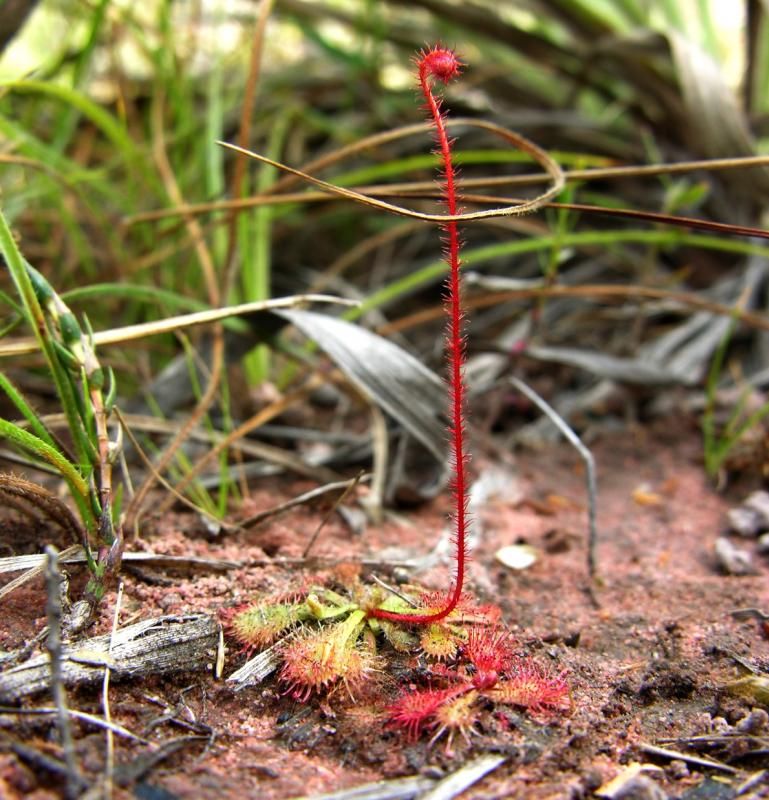
Following Saint-Hilaire’s original description from 1824, we decided to keep D. hirtella var. lutescens as a good taxon. Here’s a pic of this beautiful plant with its wine-red leaves and yellowish scapes covered in white hairs:

Last of all, here are some pics of D. cayennensis, which were also confused for members of the D. montana complex in the past (especially in the Flora Neotropica):

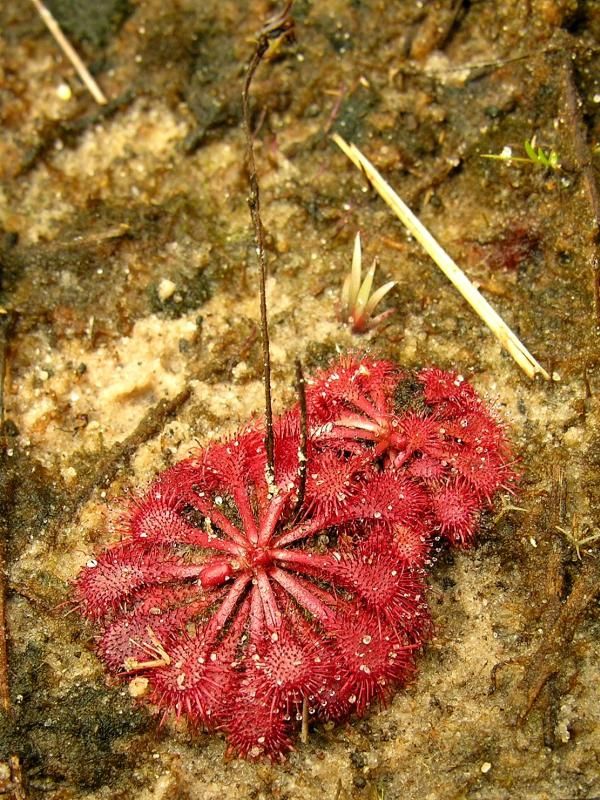
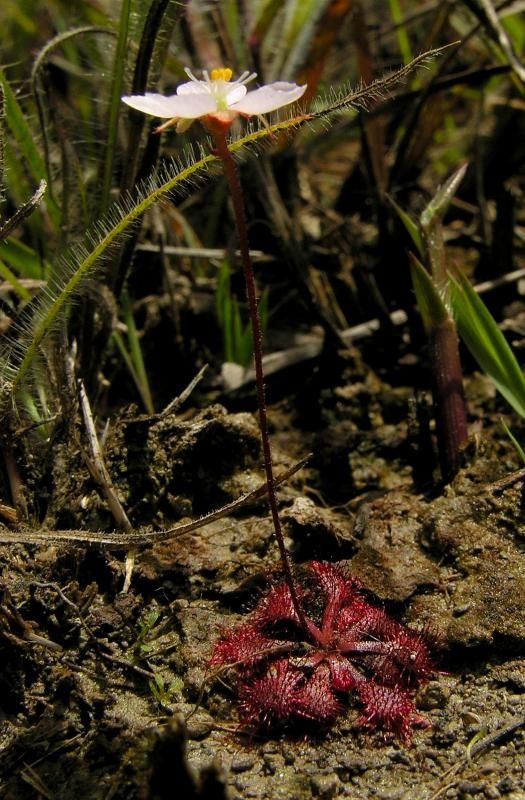
And just to avoid accusations that we are splitters (LOL), I would like to let you all know that we lumped a few names under D. cayennensis: D. colombiana, D. panamensis, D. pumilla, and D. sanariapoana.
I hope you enjoyed!
Fernando Rivadavia
P.S. Here's the paper: biotaxa.org/Phytotaxa/article/view/phytotaxa.172.3.1
Here is another call to correct your plant labels!

A few colleagues and I have just published a 35-page review of the D. montana complex. Like our previous publications on Brazilian sundews, this paper has been decades in the making and it has definitely been the most “complex” of all the sundew complexes in Brazil, at least in historical terms.
Since D. montana and D. tomentosa were originally published by Saint-Hilaire nearly 200 years ago, there have been endless cycles of synonimizations and of lumping with unrelated species – culminating with the absurd Flora Neotropica in 2005, where ten names were lazily lumped under D. montana.
In our new circumscription of the D. montana complex, we have left only D. montana, D. tomentosa var. tomentosa, D. tomentosa var. glabrata, D. tentaculata, and a new (& narrow endemic) species D. spirocalyx. This is supported by characters such as leaf shape & vernation, chromosome numbers, and molecular phylogenetic data.
Excluded from the D. montana complex (hopefully permanently) are the following taxa: D. hirtella var. hirtella, D. hirtella var. lutescens, D. schwackei Rivadavia, D. parvifolia Saint-Hilaire (= D. communis), D. cayennensis Sagot ex Diels (including D. pumilla Santos, D. colombiana Fernández, D. panamensis, and D. sanariapoana Steyermark as synonyms), D. montana f. parviflora Chodat (= D. communis), and of course D. roraimae (Klotzsch ex Diels) Maguire & Laudon.
Hopefully our new publication will set the record straight for a long while with the D. montana complex!
Anyway, see below some pics and extra info for each taxon.
First we have D. montana, which is the most widespread in the complex. Through herbarium specimens, we’ve newly discovered that this species is very common on the eastern slopes of the Andes in Bolivia, and possibly also extends into Peru and Argentina. Maybe as a result of this huge geography, it is probably not surprising that it is also somewhat diverse morphologically. However we were not able to establish clear-cut morphological lines, and thus opted to describe 3 morphotypes: Typical, Southern, and Central-western morphotypes.
The characters that distinguish D. montana include the fact that it tends to go completely dormant in the dry season, it flowers in the summer, does not form stems with age, has uniformly-sized glandular trichomes from base to apex of the scapes, long and broad ovate to oblong-ovate sepals, and has relatively delicate leaves that are oblong, oblong-spatulate or more rarely spatulate.
Here are two pics of D. montana rosettes where you can see the narrow leaves:


And two pics showing the highly glandular scapes of D. montana (pics by Nilber Silva):


Then we have another widespread and very abundant species: D. tomentosa, distinguished from other taxa by its obovate to oblong-obovate leaves (rarely oblong), with wide petioles (0.4–3 mm in width). It also shows some morphological variation across the range. Variations in density of the eglandular hairs on scapes seems to support the original description by Saint-Hilaire, splitting D. tomentosa into two varieties: D. tomentosa var. tomentosa with hairy scapes and D. tomentosa var. glabrata with glabrous to subglabrous scapes. We decided to keep these two infraspecific taxa at the varietal rank, due to the huge overlap in their geographical ranges, possible hybridization, and the fact that the sole distinguishing character (scape eglandular indumentum) is not easily quantifiable.
Here's a typical dense colony of D. tomentosa at a seepage:

Here's a view of a D. tomentosa rosette with typical broad leaves. Notice the scapes are practically hairless, meaning this is D. tomentosa var. glabrata:

Here are two pics of D. tomentosa var. glabrata, with its mostly hairless scapes (glandular only):


Here are a few pics of D. tomentosa var. tomentosa with its ultra-hairy scapes:




So why did we keep two taxa as variaties of D.tomentosa instead of at higher rank (or none)? Even though the extremes are often found growing in the same habitats with no intermediates. However hybrids are known and there are numerous populations somewhat intermediate in regards to scape hairyness. Thus, we followed Saint-Hilaire and kept varietal rank due to the difficulty in quantifying this character, until further evidence is presented. Here's a plant we classified as var.tomentosa, since hairs were found all the way up the scape, even if less dense than the ones above (pics by Nilber Silva):


And just as a reminder, D. tomentosa (both varieties) are known to freely form hybrids with D. grantsaui almost everywhere they meet, the hybrid being known as D.X fontinalis.Here's a pic of D. tomentosa var. tomentosa (L) and D.X fontinalis (R):

A relatively recent addition to this group is D. tentaculata, which I published in 2003. This species can be distinguished by its obovate, obovate-cuneate or cuneate leaves with conspicuous apical retentive (“snap) tentacles, tendency to form short stems of accumulated dead leaves, and a newly-discovered character unique among other Brazilian species: the way the young leaves unfurl (vernation) is geniculate (versus circinate in other tetraploid Brazilian taxa and the more common geniculate-involute vernation of most other New World species).
Here are some pics of D. tentaculata:







And finally we have the new species D. spirocalyx, a narrow endemic from the Serra do Cipó in SE Brazil. I originally “discovered” this species as a herbarium specimen back in the early 90’s, but only saw it in the field in 1999, thanks to precise location data provided by my friend Ms.Chiaki Shibata from Japan, who had visited the Serra do Cipó and showed me lovely pics of local CPs, including one where I recognized the plant I only knew from herbarium specimens until then (and thus the reason why it was called for many years D.sp. ”Shibata”).
Subsequent and extensive explorations over the past 15 years have only turned up a few, mostly small populations, usually growing in sandy quartzitic soils or borderline habitats where sandy soils meet mounds of white quartz gravel mixed with fine sand.
Drosera spirocalyx is distinguished by characters such as its bicolored leaves with green petioles and wine red lamina, villous adaxial petiole surface and whole abaxial leaf surface, short scapes with few flowers that open at the height of the dry season, and by the sub-orbicular to broadly ovate sepals with rounded (rarely subobtuse) apex. And it’s the sepals that give this plant its name, due to the fact that the margins of the sepals uniquely (among New World sundews) overlap when in bud and form a pyramidal projection at the fusion point between adjacent sepals.
Here’s D. spirocalyx, forming typical (clonal?) clumps:

And here you can see the plants forming columns of dead leaves (also present in D. tentaculata and D. tomentosa):


This pic by Paulo Gonella shows the characteristic that gives D. spirocalyx its name. Notice how the sepals are large and overlapping – so much so that they even form a pyramidal projection where adjacent sepals fuse. Only one other Drosera species has these bumps: D. stenopetala from New Zealand.

And just for clarity’s sake, here are some of the taxa we’ve excluded from the D. montana complex, starting with D. chimaera, which is possibly the missing link between the montana and villosa complexes:


And here’s the beautiful D. schwackei (ex- D.montana var.schwackei) in its amazing white quartz habitat:


Another species excluded from the complex is D. hirtella (ex-D. montana var. hirtella). Here’s a pic of D. hirtella var. hirtella with its reddish leaves and deeply ascending scapes covered in crisp red hairs:

Following Saint-Hilaire’s original description from 1824, we decided to keep D. hirtella var. lutescens as a good taxon. Here’s a pic of this beautiful plant with its wine-red leaves and yellowish scapes covered in white hairs:

Last of all, here are some pics of D. cayennensis, which were also confused for members of the D. montana complex in the past (especially in the Flora Neotropica):



And just to avoid accusations that we are splitters (LOL), I would like to let you all know that we lumped a few names under D. cayennensis: D. colombiana, D. panamensis, D. pumilla, and D. sanariapoana.
I hope you enjoyed!
Fernando Rivadavia
P.S. Here's the paper: biotaxa.org/Phytotaxa/article/view/phytotaxa.172.3.1






